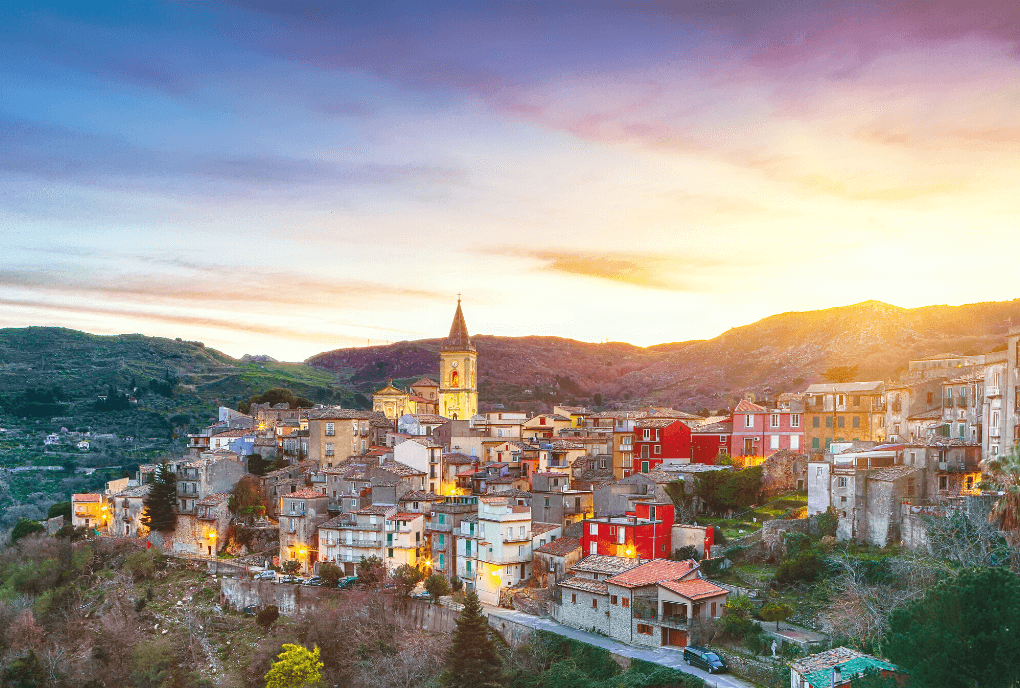
The “Stone Country”: Novara di Sicilia
On the border between the Nebrodi and Peloritani mountains, in the province of Messina, rises the “Country of Stone“, better known as Novara di Sicilia. Located at the foot of the “Matterhorn of Sicily,” its history and authentic native traditions make it one of the Most beautiful villages in Italy.
The history of the Gallo-Italic village
Novara di Sicilia is the only municipality on the island where theancient Gallic dialect. Influencing the language of the citizens were precisely the colonies from northern Italy around 1060 A.D. But the actual origins of this mountain village are older. Several years ago, some rudimentary Mesolithic dwellings in the Sperlinga Rock, near contrada Casalini.
There is evidence that this territory was first dominated by the Greeks, taking the name of Noa which from the Sican means “fallow“, thus referring to the fertile soil of the area. It was later colonized by the Romans and then by the Saracens. The latter built in contrada Casalini a castle on an overhanging cliff, the ruins of which are visible today. That fortress marked the birth of a new center, which was inhabited until the entire Byzantine era.
In 1171 Saint Hugh founded, under the reign of Roger II, the first edification Cistercian
of Sicily, as well as l’Abbey of Santa Maria Nucaria. In 1298 Novara di Sicilia was surveyed as Castrum Nucariae. The castle and the lands are first assigned to different Norman families. Then, in 1364, during the reign of Frederick IV of Aragon, it became the property of Vinciguerra D’Aragona.
What to see in the medieval village?
Among the narrow streets of Novara di Sicilia it is possible to glimpse a medieval soul that has remained intact over the years. Distinctive features of this historical period are precisely the numerous constructions o religious sculptures made of sandstone. More valuable we find the Cipollino, a local red, marble-like rock, with which architectural elaborations or artistic elements were made within historic buildings and churches.
In Novara di Sicilia, the stone working became a true art. Modeling through the stonemason passed from father to son, creating a lineage of sculptors who have become symbols of this city.
Notable monuments include the Cathedral of Santa Maria Assunta With its three sandstone aisles. No less important are the Medieval church of St. Francis of Assisi, the two Baroque churches of theAnnunziata and of Saint Hugh Abbot and finally the Church of St. Nicholas, set on a flight of stone steps.
They also deserve Stancanelli Palace, Fountain House, the Town Hall Palace, the nineteenth-century Riccardo Casalaina Theater and the numerous murals depicting the traditions of yesteryear.
Calling for more attention are l’Abbey of Santa Maria La Noara a Badiavecchia and theOld Giorginaro Water Mill. The latter active since 1690 is still used for milling durum wheat aimed at flour production.
The Matterhorn of Sicily: the Rocca Salvatesta
Just look up to catch a glimpse of the Rocca Salvatesta, a 1340-meter peak famous for its distant resemblance to the Mount Cervino. Starting from the medieval village, it is possible to follow a path surrounded by nature that leads hiking enthusiasts to the top.
Upon reaching the rocky outcrop, it is possible to see in the distance theancient city of Tindari and mountain ranges that make up this wonderful territory. L’PFM Association organizes a 4-hour guided tour of the highest mountain in the Peloritani Mountains. More information here.
The Maiorchino and the typical products of Novara di Sicilia
Novara di Sicilia is the right destination for those who want to savor the good Sicilian food at km0. The most renowned dish is the Pasta Ncasciada, a delicious pasta dish with veal and mutton ragout, Eggplant, meatballs, breadcrumbs and eggs. Also, as a good mountain village, there is no shortage of tripe, lard and legumes.
Those with a sweet tooth are delighted with the tasty typical preparations. The St. Nicholas Pastry Bar churns out treats of all kinds every day. We find the Apostle Fingers, that is, ricotta cannoli covered with icing and to Pignurada, a diced and naturally fried shortbread. Delicious are the Raviò, fried ravioli made with a dough soaked in wine and a filling of fresh ricotta cheese flavored with cinnamon.
I dairy products are not to be outdone. In almost every restaurant in the area we find the Majorcan, a local pecorino cheese aged 12 months. In addition to delighting visitors’ palates, this is also the subject of one of the country’s most famous competitions: the Majorcan Launch.
This rite dates back to the 1600s. Originally dairy farmers, to control the seasoning, they would let the cheese wheels run along the road, testing their endurance. As time went on, this “test” became a real tradition.
For the event, tracks are still being set up for the tracks along the streets Novara. The game consists of the launch different forms of such cheese through a lazzàda, that is, a shoemaker’s twine. Participating are. two teams, who in turn will choose the shooter who will go to the duel with the opponent. The winner is the one who, with the same number of throws, manages to send the Majorcan as far away as possible.
Taking advantage of this are the tourists who take the opportunity to taste the renowned pecorino cheese from the Nebrodi.
Luca Russo





